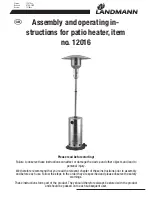
331551-002
– 13 –
GRADE
WITHIN 24 in.
BASEMENT INSTALLATION, EQUIPMENT LOCATED
IN CONFINED SPACES; ALL AIR FROM OUTDOORS.
CONFINED
SPACE
12 in. MINIMUM
ABOVE GRADE
& SNOW LEVELS
WITHIN 12 in. ABOVE
BURNER LEVEL
COMBINATION
COMBUSTION/
VENTILATION
AIR DUCT
Figure 7. Basement Installation
An opening may be used in lieu of a duct to provide the outside
air supply. It, too, must be located within 12 inches above,
and within 24 inches horizontally from, the burner level of
the appliance having the largest input. However, it must be
located at least 12 inches above the outside grade level and
be clear of snow levels. In addition, it must be equipped with
a means to prevent the direct entry of rain and wind without
reducing the required free area of the opening.
The size of openings is determined by the method in which the
air is to be provided. For specific ventilation and combustion
air requirements, consult the current edition of
“Standard for
the Installation of Oil-Burning Equipment (NFPA 31)”
and
the local codes of your area.
Louvers and Grilles
In calculating free area for ventilation and combustion
air supply openings, consideration must be given to the
blocking effect of protection louvers, grilles, and screens.
These devices can reduce airflow, which in turn may require
larger openings to achieve the required minimum free area.
Screens must not be smaller than 1/4 inch mesh. If the free
area through a particular design of louver or grille is known,
it should be used in calculating the specified free area of the
opening. If the design and free area are not known, it can
be assumed that most wood louvers will allow 20 - 25% of
free area while metal louvers and grilles will allow 60 - 75%
of free area.
Louvers and grilles must be interconnected with the equipment
so that they are opened automatically during equipment
operation. Also, keep louvers and grilles clean and free of
debris or other obstructions. Do not use manually adjustable
louvers.
Consult the local codes of your area for specific ventilation
and combustion air requirements.
Vent and Exhaust Connections
The vent and exhaust connections must comply with the
requirements of the current edition of
“Standard for the
Installation of Oil-Burning Equipment (NFPA 31)”.
Vent Pipe System
This water heater uses a non-direct, single-pipe vent system
to remove exhaust gases created by the burning of fossil
fuels. Air for combustion is taken from the immediate water
heater location or is ducted in from the outside (see "Air
Requirements" and "Vent and Exhaust Connections")
This water heater must be properly vented for the removal of
exhaust gases to the outside atmosphere. Correct installation
of the vent pipe system is mandatory for the proper and
efficient operation of this water heater and is an important
factor in the life of the unit.
The vent pipe must be installed according to the current edition
of
“Standard for the Installation of Oil-Burning Equipment
(NFPA 31)”
and all local/state codes.
The vent pipe installation must not be obstructed so as
to prevent the removal of exhaust gases to the outside
atmosphere.
Important:
•
The use of vent dampers is not recommended by the
manufacturer of this water heater. Although some vent
dampers are certified by CSA International, this certification
applies to the vent damper device only and does not mean
they are certified for use on this water heater.
•
Certified (listed) carbon monoxide (CO) detectors are
recommended in all applications and should be installed
using the manufacturer’s instructions and local codes,
rules, or regulations.
•
The venting system must be installed by a qualified
technician.
General Chimney Requirements
All oil-heaters shall be connected to a chimney having
sufficient draft at all times to ensure for safe and proper
operation, except those heaters that are specifically certified
for other means of venting (JW6 F307V - Direct vent models).
For a burner designed for natural draft connect the vent to a
vertical chimney. Insufficient draft can cause flue gas leakage
and carbon monoxide emissions, which can lead to severe
bodily injury or death. Use vent material approved by local
codes for oil-fired burners. In the absence of such codes, refer
to the current edition of
•
“Standard for the Installation of Oil-Burning Equipment
(NFPA 31)”.
•
“Standard for Chimneys, Fireplaces, Vents, and Solid
Fuel-Burning Appliances (NFPA 211)”.
Inspect existing chimney before installing the water heater.
Failure to do any of the following can result in serious property
damage, severe bodily injury or death:
•
Clean the chimney, including removal of blockage.
•
Repair or replace damaged pipe or liner.
•
Repair mortar and joints.
To prevent downdrafts, extend the chimney at least 3 ft. above
the highest point where it passes through the roof and 24 in.
higher than any portion of the building within 10 ft. .














































